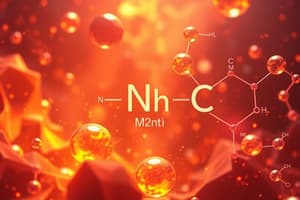Podcast
Questions and Answers
What is the chemical formula of the precipitate formed when FeCl3 reacts with ammonium hydroxide?
What is the chemical formula of the precipitate formed when FeCl3 reacts with ammonium hydroxide?
- Fe2O3
- FeCl2
- NH4Cl
- Fe(OH)3 (correct)
What is the purpose of adding 6M HCl to the solution containing the red-brown precipitate in the Fe3+ test?
What is the purpose of adding 6M HCl to the solution containing the red-brown precipitate in the Fe3+ test?
- To neutralize the ammonium hydroxide solution
- To dissolve the ferric hydroxide precipitate (correct)
- To oxidize the Fe3+ ions
- To precipitate the Fe3+ ions as FeCl3
Which of the following is NOT a characteristic of the test for Ca2+?
Which of the following is NOT a characteristic of the test for Ca2+?
- A white precipitate is formed
- The precipitate is soluble in HCl (correct)
- The reaction occurs in an alkaline medium
- Ammonium oxalate is used as the reagent
What is the purpose of adding ammonia to the solution containing Ca(NO3)2 in the Ca2+ test?
What is the purpose of adding ammonia to the solution containing Ca(NO3)2 in the Ca2+ test?
In both tests, what is the purpose of using a clean dry tube?
In both tests, what is the purpose of using a clean dry tube?
Flashcards
Fe3+ test
Fe3+ test
Ferric ions react with ammonium hydroxide to form a red-brown precipitate of ferric hydroxide. This precipitate dissolves when reacted with hydrochloric acid.
Ca2+ test
Ca2+ test
Calcium ions react with ammonium oxalate in an alkaline medium to form a white precipitate of calcium oxalate.
Fe3+ reaction with ammonia
Fe3+ reaction with ammonia
A red-brown precipitate is formed when ferric ions react with ammonium hydroxide.
Ca2+ reaction with oxalate
Ca2+ reaction with oxalate
Signup and view all the flashcards
Ferric hydroxide dissolving in acid
Ferric hydroxide dissolving in acid
Signup and view all the flashcards
Study Notes
Tests for Positive lons (Cations)
A. Test for Fe³⁺
- Ferric ions react with ammonium hydroxide to form a red-brown precipitate of ferric hydroxide.
- The chemical reaction is Fe³⁺ + 3OH⁻ → Fe(OH)₃↓ (red-brown ppt)
- This precipitate can be confirmed by adding 6M HCl, which causes the red-brown precipitate to dissolve.
Procedure
- Add 1 mL of 0.1 M FeCl₃ solution into a clean dry test tube.
- Add 0.5 mL of ammonium hydroxide and observe the formation of the red-brown precipitate.
- Add 0.5 mL of 6M HCl and shake to observe the disappearance of the red precipitate.
B. Test for Ca²⁺
- A calcium-containing solution reacts with ammonium oxalate in an alkaline medium to form a white precipitate of calcium oxalate.
- The chemical reaction is Ca(NO₃)₂ + (NH₄)₂C₂O₄ → CaC₂O₄↓ + 2NH₄NO₃
- Calcium oxalate is a white precipitate.
Procedure
- Add 1 mL of drops of 0.1M Ca(NO₃)₂ solution into a clean dry test tube.
- Add 0.5 mL of 6M ammonia and shake gently.
- Add 0.5 mL of (NH₄)₂C₂O₄ and observe the formation of the white calcium oxalate precipitate.
Studying That Suits You
Use AI to generate personalized quizzes and flashcards to suit your learning preferences.




